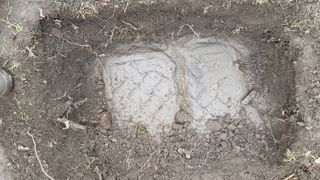Teen Boy Discovers Long-Lost Medieval Gravestones in Scottish Churchyard

A trio of lost Medieval gravestones have been rediscovered in an Scottish churchyard.
The stones, carved with elaborate, interlacing patterns, were found by a 14-year-old boy during an archaeological survey of the Old Parish Church in Govan, a town established in the Middle Ages that is now part of the city of Glasgow.
"I was just prodding the ground to see if there was anything there, and suddenly it made a noise and I realized I had hit something," the discoverer, Mark McGettigan, said in a statement. [See Photos of the 'Lost' Medieval Gravestones]
Legacy lost
McGettigan had hit a trace of the Govan of 1,000 years ago. Today's Govan Old Parish Church stands on the site of an older site of worship, the Church of St. Constantine. Archaeologists have found Christian artifacts at the site that date back to at least the year 500, but Govan is most famous for its carved stones that date to between the years 800 and 1000. According to the Govan Old Parish Church, the most impressive of the stones was carved during the early part of this period. It's a sarcophagus made from a single hunk of stone, carved with images of a warrior astride a horse.

In the centuries after the sarcophagus was made, local artisans continued a tradition of intricate carving, making stone crosses and long, sloped slabs called "hogbacks" that were used as grave markers. These artisans also carved flat stone slabs called cross-slabs, which were laid over the surfaces of graves. At the time the carvings were made, Gavon was part of the Kingdom of Strathclyde, which lasted from around the seventh century until it was conquered by the Scots in the 11th century.
Thirty-one Govan Stones had already been found and preserved within the parish church museum, but another 15 were thought to be forever lost. In the 1970s, the walls of the shipyard next to the church were demolished, and the Govan Stones that hadn't already been brought indoors were thought to have been crushed and carted away with the rubble.
Stones unearthed
The discovery of three Govan Stones buried in the churchyard reveals that at least some of these lost stones survived. McGettigan was volunteering on his first-ever archaeological dig when he discovered the first of the stones. The dig was run by the charity Northlight Heritage, with funding from the Glasgow City Region City Deal and the Govan Cross Townscape Heritage Initiative. [In Photos: Stone Monument Discovered in Scotland]
Sign up for the Live Science daily newsletter now
Get the world’s most fascinating discoveries delivered straight to your inbox.
"This is the most exciting discovery we have had at Govan in the last 20 years," Stephen Driscoll, a professor of historical archaeology at the University of Glasgow and a member of The Govan Heritage Trust, said in the statement. "The Govan Stones are a collection of international importance, and these recovered stones reinforce the case for regarding Govan as a major early medieval center of power."
The three rediscovered stones are carved with Celtic interlacing designs and crosses, much like the ones already on display within the church. The stones are largely intact, though worn in spots. No remains were found along with the stones, which have been moved around the graveyard and even re-carved and reused over the centuries, said archaeologist and Love Archaeology spokesman Tom Horne.
The archaeologists said they hope the discoveries mean that more of the lost stones survive. The Govan Old Parish Church is currently being refurbished, and the collection of stones will ultimately get a fresh, new display, Driscoll said. In the meantime, volunteers continue to search the old graveyard.
"I am extremely happy," McGettigan said. "In fact, I'm ecstatic at what I helped to uncover."
- The 25 Most Mysterious Archaeological Finds on Earth
- 7 Bizarre Ancient Cultures That History Forgot
- In Photos: A Gladiator Burial Pit
Originally published on Live Science.

Stephanie Pappas is a contributing writer for Live Science, covering topics ranging from geoscience to archaeology to the human brain and behavior. She was previously a senior writer for Live Science but is now a freelancer based in Denver, Colorado, and regularly contributes to Scientific American and The Monitor, the monthly magazine of the American Psychological Association. Stephanie received a bachelor's degree in psychology from the University of South Carolina and a graduate certificate in science communication from the University of California, Santa Cruz.
